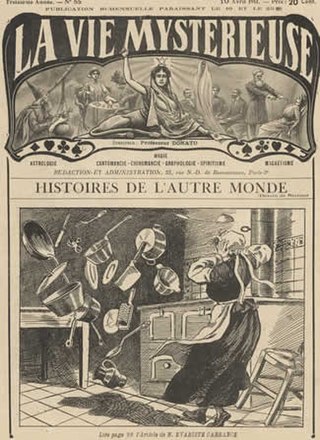
In German folklore and ghostlore, a poltergeist is a type of ghost or spirit that is responsible for physical disturbances, such as loud noises and objects being moved or destroyed. Most claims or fictional descriptions of poltergeists show them as being capable of pinching, biting, hitting, and tripping people. They are also depicted as capable of the movement or levitation of objects such as furniture and cutlery, or noises such as knocking on doors. Foul smells are also associated with poltergeist occurrences, as well as spontaneous fires and different electrical issues such as flickering lights.
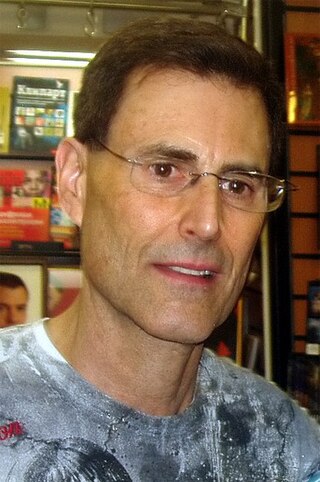
Uri Geller is an Israeli-British illusionist, magician, television personality, and self-proclaimed psychic. He is known for his trademark television performances of spoon bending and other illusions. Geller uses conjuring tricks to simulate the effects of psychokinesis and telepathy. Geller's career as an entertainer has spanned more than four decades, with television shows and appearances in many countries. Magicians have called Geller a fraud because of his claims of possessing psychic powers.
Project Alpha was an effort by magician James Randi to test the quality of scientific rigor of a well-known test of paranormal phenomena.
Zé Arigó was a faith healer and proponent of psychic surgery. He claimed to have performed psychic surgery with his hands or with simple kitchen utensils while in a mediumistic trance, therefore he was also known as the Surgeon of the Rusty Knife. During his operations he supposedly embodied the spirit of Dr. Adolf Fritz.
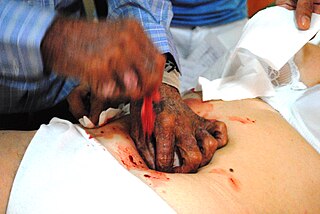
Psychic surgery is a pseudoscientific medical fraud in which practitioners create the illusion of performing surgery with their bare hands and use sleight of hand, fake blood, and animal parts to convince the patient that diseased lesions have been removed and that the incision has spontaneously healed.
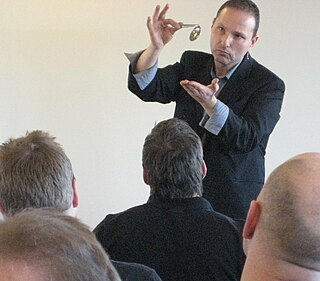
Spoon bending is the deformation of objects, especially metal cutlery, purportedly by paranormal means. It is a common theme for magic tricks, which use a variety of methods to produce the effect. Performers commonly use misdirection to draw their audience's attention away while the spoon is manually bent. Another method uses a metal spoon that has been prepared by repeatedly bending the spoon back and forth, weakening the material. Applying light pressure will then cause it to bend or break.

Hans Bender was a German lecturer on the subject of parapsychology, who was also responsible for establishing the parapsychological institute Institut für Grenzgebiete der Psychologie und Psychohygiene in Freiburg. For many years his pipe smoking, contemplative figure was synonymous with German parapsychology. He was an investigator of 'unusual human experience', e.g. poltergeists and clairvoyants. One of his most famous cases was the Rosenheim Poltergeist.

The Enfield poltergeist was a claim of supernatural activity at 284 Green Street, a council house in Brimsdown, Enfield, London, England, between 1977 and 1979. The alleged poltergeist activity was centred on sisters Janet, aged 11, and Margaret Hodgson, aged 13.

William G. Roll was an American psychologist and parapsychologist on the faculty of the Psychology Department of the University of West Georgia in Carrollton, Georgia. Roll is most notable for his belief in poltergeist activity. He coined the term "recurrent spontaneous psychokinesis" (RSPK) to explain poltergeist cases. However, RSPK was never accepted by mainstream science and skeptics have described Roll as a credulous investigator.

Joe Nickell is an American skeptic and investigator of the paranormal.
Tina Resch was a central figure in a series of incidents that came to be called the Columbus poltergeist case. In 1984, alleged telekinesis events at her Columbus, Ohio home drew significant news media interest. A series of color photographs taken by photojournalist Fred Shannon, and published by The Columbus Dispatch, were purported to show Resch sitting in an armchair with a telephone handset and phone cord flying in front of her. Resch's story, and Shannon's photography, were featured on a 1993 episode of Unsolved Mysteries.

Hans Holzer was an Austrian-American author and parapsychologist. He wrote more than 120 books on supernatural and occult subjects for the popular market as well as several plays, musicals, films, and documentaries, and hosted a television show, Ghost Hunter.

Ghost hunting is the process of investigating locations that are purportedly haunted by ghosts. The practice has been heavily criticized for its dismissal of the scientific method. No scientific study has ever been able to confirm the existence of ghosts. Ghost hunting is considered a pseudoscience by the vast majority of educators, academics, science writers and skeptics. Science historian Brian Regal described ghost hunting as "an unorganized exercise in futility".
John Gerald Taylor was a British physicist and author. He is notable for writing a book critical of paranormal phenomena.
Guy Lyon Playfair was a British writer, best known for his books about parapsychology and his investigation of the Enfield poltergeist.
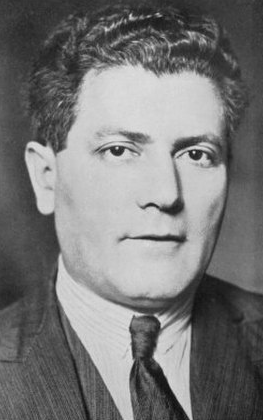
Nandor Fodor was a British and American parapsychologist, psychoanalyst, author and journalist of Hungarian origin.

Banachek is an English mentalist, magician, and "thought reader".

Telekinesis is a purported psychic ability allowing an individual to influence a physical system without physical interaction. Experiments to prove the existence of telekinesis have historically been criticized for lack of proper controls and repeatability. There is no reliable evidence that telekinesis is a real phenomenon, and the topic is generally regarded as pseudoscience.
Anita Gregory was a German-born British psychologist and parapsychologist. Gregory was a lecturer at the Polytechnic of North London. She was a member of the Society for Psychical Research and conducted experiments with the British psychic Matthew Manning.
Masuaki Kiyota is a Japanese psychic known for his alleged ability of thoughtography.











